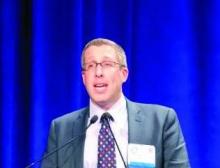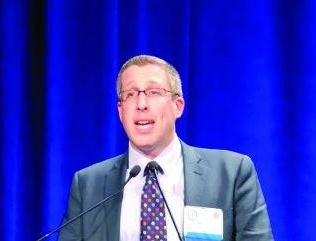User login
PHILADELPHIA – Use of a device on the distal end of a colonoscope to expand the view of the colon lowered the mean inspection time during colonoscopy without significantly reducing adenoma or sessile serrated polyp detection rate, according to a presentation at the annual meeting of the American College of Gastroenterology.
“The finger projections on the tip of the Endocuff can engage the colonic folds, and that allows us to see the proximal sides of these folds,” Seth A. Gross, MD, chief of gastroenterology at NYU Langone Health Tisch Hospital in New York, said in his presentation. “It also changes topography and temporarily stretches different segments of the colon depending on where you are to help expose more surface area and ultimately identify more polyps.”
Dr. Gross and his colleagues analyzed the withdrawal time of colonoscopy with the Endocuff Vision (Olympus, Center Valley, Penn.) in 101 patients, compared with withdrawal time during a standard colonoscopy in 99 patients as measured by stopwatch. Other endpoints in the study included insertion time, adenoma detection rate (ADR), sessile serrated polyp detection (SSPD), and number of adenomas and sessile serrated polyps per colonoscopy. Patients were included if they were at least 40 years old with a screening, surveillance, or diagnostic indication for colonoscopy; they were excluded if they had inflammatory bowel disease, polyposis syndrome, prior colon resection, prior colorectal polyp or cancer, previous incomplete colonoscopy or severe diverticular disease.
Inspection time in the Endocuff group was 6.3 minutes, compared with 8.2 minutes in the standard colonoscopy group (P less than .001), and insertion time was 9.9 minutes in the Endocuff group, compared with 11.3 minutes in the standard colonoscopy group. A multivariate analysis showed the shorter inspection times in the Endocuff group remained significant (P less than .0001).
In the Endocuff group, ADR was 61.4% with 1.43 adenomas per colonoscopy, while the standard colonoscopy group had an ADR of 52.5% with an adenoma detection rate of 1.07 per colonoscopy. SSPD was 19.8% in the Endocuff group and 11.1% in the standard group with a SSPD per colonoscopy of 0.27 and 0.21, respectively.
The study was unblinded and there were two endoscopists performing the procedures, which raises the question of whether the results could be generalized to other gastroenterologists, Dr. Gross noted.
“We recommend that future studies that are meant to be powered for adenoma detection rate and sessile serrated lesions be done to sort of validate this, and probably have more endoscopists involved in a study like this,” Dr. Gross said. “But this is the start of an interesting conversation where one could be more efficient without sacrificing our detection rate for both adenomas and sessile serrated lesions.”
Dr. Gross reports a consultancy with Olympus.
SOURCE: Gross SA et al. ACG 2018, Presentation 37.
PHILADELPHIA – Use of a device on the distal end of a colonoscope to expand the view of the colon lowered the mean inspection time during colonoscopy without significantly reducing adenoma or sessile serrated polyp detection rate, according to a presentation at the annual meeting of the American College of Gastroenterology.
“The finger projections on the tip of the Endocuff can engage the colonic folds, and that allows us to see the proximal sides of these folds,” Seth A. Gross, MD, chief of gastroenterology at NYU Langone Health Tisch Hospital in New York, said in his presentation. “It also changes topography and temporarily stretches different segments of the colon depending on where you are to help expose more surface area and ultimately identify more polyps.”
Dr. Gross and his colleagues analyzed the withdrawal time of colonoscopy with the Endocuff Vision (Olympus, Center Valley, Penn.) in 101 patients, compared with withdrawal time during a standard colonoscopy in 99 patients as measured by stopwatch. Other endpoints in the study included insertion time, adenoma detection rate (ADR), sessile serrated polyp detection (SSPD), and number of adenomas and sessile serrated polyps per colonoscopy. Patients were included if they were at least 40 years old with a screening, surveillance, or diagnostic indication for colonoscopy; they were excluded if they had inflammatory bowel disease, polyposis syndrome, prior colon resection, prior colorectal polyp or cancer, previous incomplete colonoscopy or severe diverticular disease.
Inspection time in the Endocuff group was 6.3 minutes, compared with 8.2 minutes in the standard colonoscopy group (P less than .001), and insertion time was 9.9 minutes in the Endocuff group, compared with 11.3 minutes in the standard colonoscopy group. A multivariate analysis showed the shorter inspection times in the Endocuff group remained significant (P less than .0001).
In the Endocuff group, ADR was 61.4% with 1.43 adenomas per colonoscopy, while the standard colonoscopy group had an ADR of 52.5% with an adenoma detection rate of 1.07 per colonoscopy. SSPD was 19.8% in the Endocuff group and 11.1% in the standard group with a SSPD per colonoscopy of 0.27 and 0.21, respectively.
The study was unblinded and there were two endoscopists performing the procedures, which raises the question of whether the results could be generalized to other gastroenterologists, Dr. Gross noted.
“We recommend that future studies that are meant to be powered for adenoma detection rate and sessile serrated lesions be done to sort of validate this, and probably have more endoscopists involved in a study like this,” Dr. Gross said. “But this is the start of an interesting conversation where one could be more efficient without sacrificing our detection rate for both adenomas and sessile serrated lesions.”
Dr. Gross reports a consultancy with Olympus.
SOURCE: Gross SA et al. ACG 2018, Presentation 37.
PHILADELPHIA – Use of a device on the distal end of a colonoscope to expand the view of the colon lowered the mean inspection time during colonoscopy without significantly reducing adenoma or sessile serrated polyp detection rate, according to a presentation at the annual meeting of the American College of Gastroenterology.
“The finger projections on the tip of the Endocuff can engage the colonic folds, and that allows us to see the proximal sides of these folds,” Seth A. Gross, MD, chief of gastroenterology at NYU Langone Health Tisch Hospital in New York, said in his presentation. “It also changes topography and temporarily stretches different segments of the colon depending on where you are to help expose more surface area and ultimately identify more polyps.”
Dr. Gross and his colleagues analyzed the withdrawal time of colonoscopy with the Endocuff Vision (Olympus, Center Valley, Penn.) in 101 patients, compared with withdrawal time during a standard colonoscopy in 99 patients as measured by stopwatch. Other endpoints in the study included insertion time, adenoma detection rate (ADR), sessile serrated polyp detection (SSPD), and number of adenomas and sessile serrated polyps per colonoscopy. Patients were included if they were at least 40 years old with a screening, surveillance, or diagnostic indication for colonoscopy; they were excluded if they had inflammatory bowel disease, polyposis syndrome, prior colon resection, prior colorectal polyp or cancer, previous incomplete colonoscopy or severe diverticular disease.
Inspection time in the Endocuff group was 6.3 minutes, compared with 8.2 minutes in the standard colonoscopy group (P less than .001), and insertion time was 9.9 minutes in the Endocuff group, compared with 11.3 minutes in the standard colonoscopy group. A multivariate analysis showed the shorter inspection times in the Endocuff group remained significant (P less than .0001).
In the Endocuff group, ADR was 61.4% with 1.43 adenomas per colonoscopy, while the standard colonoscopy group had an ADR of 52.5% with an adenoma detection rate of 1.07 per colonoscopy. SSPD was 19.8% in the Endocuff group and 11.1% in the standard group with a SSPD per colonoscopy of 0.27 and 0.21, respectively.
The study was unblinded and there were two endoscopists performing the procedures, which raises the question of whether the results could be generalized to other gastroenterologists, Dr. Gross noted.
“We recommend that future studies that are meant to be powered for adenoma detection rate and sessile serrated lesions be done to sort of validate this, and probably have more endoscopists involved in a study like this,” Dr. Gross said. “But this is the start of an interesting conversation where one could be more efficient without sacrificing our detection rate for both adenomas and sessile serrated lesions.”
Dr. Gross reports a consultancy with Olympus.
SOURCE: Gross SA et al. ACG 2018, Presentation 37.
REPORTING FROM ACG 2018
Key clinical point: Inspection times were lower during colonoscopy for patients who underwent the procedure using Endocuff, but there was no significant decrease in adenoma or sessile serrated polyp detection rate.
Major finding: Endocuff reduced inspection time to 6.3 minutes, compared with 8.2 minutes in the standard colonoscopy group.
Study details: An analysis of 200 patients who underwent standard colonoscopy or colonoscopy with Endocuff Vision.
Disclosures: Dr. Gross reports a consultancy with Olympus.
Source: Gross SA et al. ACG 2018, Presentation 37.

